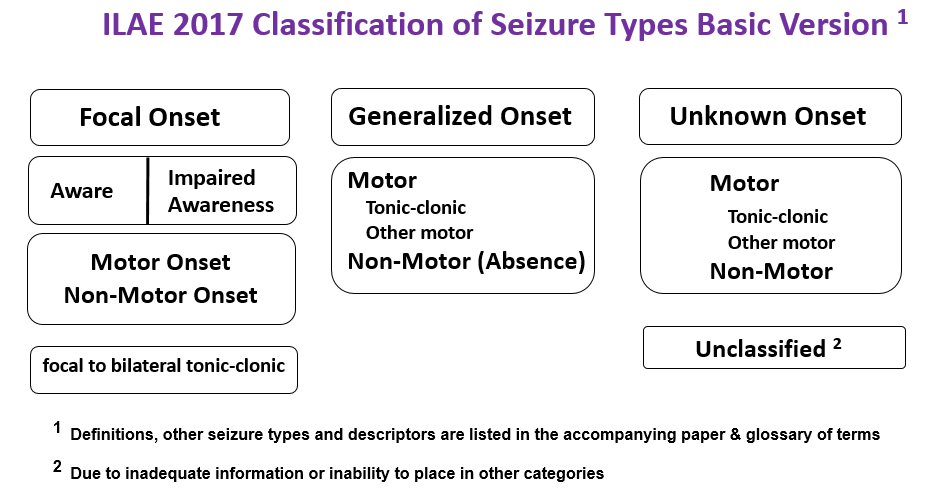The International League Against Epilepsy (ILAE) is the world’s main scientific body devoted to the study of epilepsy, and it has recently revised its classification of seizures. The changes will help make diagnosing and classifying seizures easier and more accurate.
In this article, you’ll find the new general outline of basic seizure classification. An expanded view of seizure classification has also been developed and will be updated in the coming weeks.
Background
People with epilepsy have recurring seizures that often occur spontaneously and without warning. The official definition of a seizure is “a transient occurrence of signs and/or symptoms due to an abnormal excessive or synchronous neuronal activity in the brain.”
- This means that during a seizure, large numbers of brain cells are activated abnormally at the same time. It is like an “electrical storm” in the brain.
- The nature of the seizures depends on many factors, such as the person’s age, the sleep-wake cycle, prior injuries to the brain, genetic tendencies, medications, which circuits in the brain are involved, and many others.
Separating seizures into different types helps guide further testing, treatment and prognosis or outlook. Using a common language for seizure classification also makes it easier to communicate among clinicians caring for people with epilepsy and doing research on epilepsy. The classification also provides common words for people with epilepsy and the general public to describe their seizures.
History of Seizure Classification
- For decades, the most common words to describe seizures were grand mal and petit mal. Although the medical meaning of these terms was fairly precise, some people often used them loosely when referring to any big or little seizure.
- For over 35 years, the terms partial and generalized seizures were used to describe types of seizures. This system divided seizures into partial (seizures starting in one area or side of the brain) and generalized (seizures starting in both sides of the brain at the same time).
- Partial seizures were then defined by whether a person was aware or conscious during the seizure.
- Simple partial seizures – person is aware of what happens during the event
- Complex partial seizures – person has some impaired awareness during the seizure. They may be confused, partially aware, or not aware of anything during a seizure.
- The old classifications worked for many years but did not capture many types of seizures. This new version will hopefully be more complete.
The New Basic Classification
The new basic seizure classification is based on 3 key features.
- Where seizures begin in the brain
- Level of awareness during a seizure
- Other features of seizures
Defining Where Seizures Begin
The basic classification is a simple version of the major categories of seizures. The first step is to separate seizures by how they begin in the brain. The type of seizure onset is important because it affects choice of seizure medication, possibilities for epilepsy surgery, outlook, and possible causes.
- Focal seizures: Previously called partial seizures, these start in an area or network of cells on one side of the brain.
- Generalized seizures: Previously called primary generalized, these engage or involve networks on both sides of the brain at the onset.
- Unknown Onset: If the onset of a seizure is not known, the seizure falls into the unknown onset category. Later on, the seizures type can be changed if the beginning of a person’s seizures becomes clear.
- Focal to bilateral seizure: A seizure that starts in one side or part of the brain and spreads to both sides has been called a secondary generalized seizures. Now the term generalized refers only to the start of a seizure. The new term for secondary generalized seizure would be a focal to bilateral seizure.
Describing Awareness
Whether a person is aware during a seizure is of practical importance because it is one of the main factors affecting a person’s safety during a seizure. Awareness is used instead of consciousness, because it is simpler to evaluate.
- Focal aware: If awareness remains intact, even if the person is unable to talk or respond during a seizure, the seizure would be called a focal aware seizure. This replaces the term simple partial.
- Focal impaired awareness: If awareness is impaired or affected at any time during a seizure, even if a person has a vague idea of what happened, the seizure would be called focal impaired awareness. This replaces the term complex partial seizure.
- Awareness unknown: Sometimes it’s not possible to know if a person is aware or not, for example if a person lives alone or has seizures only at night. In this situation, the awareness term may not be used or it would be described as awareness unknown.
- Generalized seizures: These are all presumed to affect a person’s awareness or consciousness in some way. Thus no special terms are needed to describe awareness in generalized seizures.
Describing Motor and Other Symptoms in Focal Seizures
Many other symptoms may occur during a seizure. In this basic system, seizure behaviors are separated into groups that involve movement.
- Focal motor seizure: This means that some type of movement occurs during the event. For example twitching, jerking, or stiffening movements of a body part or automatisms (automatic movements such as licking lips, rubbing hands, walking or running).
- Focal non-motor seizure: This type of seizure has other symptoms that occur first, such as changes in sensation, emotions, thinking or experiences.
- It is also possible for a focal aware or impaired awareness seizure to be sub-classified as motor or non-motor onset.
- Auras: The term aura to describe symptoms a person may feel in the beginning of a seizure is not in the new classification. Yet, people may continue to use this term. It’s important to know that in most cases, these early symptoms may be the start of a seizure.
Describing Generalized Onset Seizures
Seizures that start in both sides of the brain, called generalized onset, can be motor or non-motor.
- Generalized motor seizure: The generalized tonic-clonic seizure term is still used to describe seizures with stiffening (tonic) and jerking (clonic). This loosely corresponds to “grand mal.†Other forms of generalized motor seizures may happen. Many of these terms have not changed and a few new terms have been added. (see image)
- Generalized non-motor seizure: These are primarily absence seizures and the term corresponds to the old term “petit mal.†These seizures involve brief changes in awareness, staring and some may have automatic or repeated movements like lipsmacking.
Describing Unknown Onset Seizures
When the beginning of a seizure is not known, this classification still gives a way to describe whether the features are motor or non-motor.
The New Expanded Classification
The expanded classification keeps the framework of the basic classification, but adds more seizure types as subheadings. In the following graph, the types of features under motor and non-motor seizures are listed for all types- focal, generalized and unknown onset.

General Comments
Classification of a seizure type is only part of the seizure description. The work to update the seizure classification has been done by a large group of dedicated people in epilepsy over a number of years. This new system will move us forward, making it easier to describe seizures and using a common language to talk about them.
A few other points
- The new classification is designed to have some flexibility. Use of other descriptive terms or even free text is encouraged.
- Most seizures can be classified by signs and symptoms that happen during a seizure. However, other information is useful when available, for example, phone videos, EEG, MRI and other brain imaging, blood tests, or gene tests. For practical purposes, long descriptive terms are probably not useful for day to day life.
This new seizure classification does not change the definition of epilepsy or epilepsy syndromes. The ILAE also has produced a new classification of the epilepsies, which we look forward to learning more about. The epilepsy classification includes the whole clinical picture, with information on seizure types, causes, EEG pattern, brain imaging, genetics and epilepsy syndromes, such as Lennox-Gastaut syndrome and juvenile myoclonic epilepsy.
Authored by: Robert S. Fisher MD, PhD,  Patricia Shafer RN, MN and Carol D’Souza – 12/16
Reviewed by: Joseph I. Sirven MD – 12/16
Adapted from : http://www.epilepsy.com/article/2016/12/2017-revised-classification-seizures






